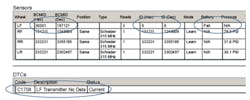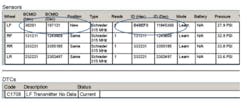Tech Tip: TPMS vehicle inspection reports break down complex issues
TPMS service can be challenging. Educating the consumer can be even more difficult. Having a TPMS vehicle inspection report as a guide makes informing the customer much easier. This type of report should contain most, if not all the information needed to assist in the diagnosis and repair of common TPMS issues.
The most common TPMS issues are related to the TPMS sensor either not functioning, not being properly relearned to the vehicle, being missing, or being in the incorrect position. Using the proper TPMS tool to test for these scenarios, then display the information in an intuitive report is an accurate and fast way to get your customer’s TPMS issues resolved.
It’s important to note that in the cases of a nonfunctioning, not relearned, or missing TPMS sensor, the TPMS MIL may not be evident. In other words, it can sometimes take a long while before a failed or missing TPMS sensor actually shows as a TPMS MIL (flashing light). This makes “Test Before you Touch” an absolutely necessity. This table summarizes typical TPMS sensor failure scenarios.
To further understand and better diagnose these scenarios, look to the TPMS inspection report. For example, in the case of a nonfunctioning sensor, the inspection report may look like the following sample:
Note that for wheel position left front (LF), there are zeros for the ID’s as read by the tool. You can also note the ID’s that are still registered (or stored) in the body control module (BCMID). This information combined with the corresponding diagnostic trouble code (DTC) is the exact type of information that should be shared with your customer as you walk them through the diagnosis.
Another common scenario is the TPMS Sensor not relearned to the control module. Your customer arrives with a TPMS MIL (flashing light). You get your TPMS tool out and perform 'test before touch', however you find that despite the presence of a MIL, all of the sensors are functioning properly and are the right parts for the vehicle ... Here comes the importance of the ability to connect via the OBD-II port and to quote a famous radio personality, “Get the rest of the story!”
The following data can be found simply by reading the stored information (in the BCM) and comparing it to what was tested or read by the tool. In the case of the un-relearned system, the inspection report might look like the following:
Note that the sensor installed in the left front position, while functioning, is new. You will also see that the sensor ID as read by the tool does not match what is stored in the control module. This would explain the TPMS MIL the customer is experiencing. This would also point you in the direction of an easy solution. Simply perform a TPMS relearn, which will write the correct Sensor ID, and clear the corresponding DTC.
These are just two examples of how having more detailed information can help sort through a TPMS diagnosis, while at the same time, provide ample information to share with your customer. Successful TPMS service (and creating happier customers) is one part diagnostics and one part “talking TPMS.” The inspection report can help accomplish both.
Information provided by Bartec USA





